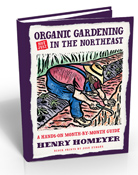Surviving From Your Garden
Imagine that a massive earthquake disrupted bridges, roads and power lines. Power and transportation could be interrupted for months, even a year. How long could you survive on the food you grow? I asked myself that recently, and I≠m not sure I liked the answer.
The question was prompted by an interesting book: The Resilient Gardener: Food Production and Self-Reliance in Uncertain Times Including the Five Crops You Need to Survive and Thrive √ Potatoes, Corn, Beans, Squash and Eggs by Carol Deppe (Chelsea Green 2010). The book is not so much a primer for survivalists, but a guide to gardening in any hard times √ personal or cataclysmic. What would happen, for example, if you could not tend or water your garden for a month or so due to illness or injury? Would your plants die of thirst or be swallowed whole by weeds? Ms. Deppe does imagine that climate change, or even war/terrorism might interfere with the food production system, but those ideas are just planted to provoke the reader, I think, to look at how and what we grow.
The author is gluten intolerant, which prompted her to look at flint corn many years ago as an alternative to wheat, something she could grind and use for bread and porridge. She grew dozens of kinds of beans for drying until she found those that could grow without irrigation or chemical fertilizers in the Northwest where she lives. She grew many kinds of winter squash to find those that store for months and those that can be dried to store even longer √ while still tasting good.
In praise of potatoes she writes, ≥After water, the most important nutritional factor is calories. A garden that is going to get you through hard times has to produce calories, not just salads. In temperate regions there is not crop capable of yielding more calories per square foot that the potato.≈ She goes on to note that potatoes also produce protein, second only to beans as a source of protein.
Lastly, Ms Deppe raises chickens and ducks for eggs and meat, though mostly for eggs. She does admit that in very cold climates (such as we have in New England) getting a flock of chickens or ducks through the winter is an expense √ they cannot forage for food, and must be fed. I have thought about having a flock of chickens or ducks for egg production but so far have held off. But ducks do intrigue me √ they are great bug eaters, love slugs, are easily contained and herded. Still they are messy and need extra care in winter.
The author really has done her homework on all the crops she describes, and presents lots of information I haven≠t found elsewhere. She covers not only what varieties to grow and how to grown them, but how to store and cook with them. Not only nutritional value is important, she notes, but also flavor √ and not all beans or squash are equally tasty.
I learned that three species of squash are grown in North America: Cucurbita maxima, C. pepo, and C. moschata. The first species, C. maxima includes Blue Hubbards, Buttercups, Kuri, Marina di Chiogga squash and Cinderella pumpkins. All these get their best flavor after a curing period of a month or more √ and may reach maximum flavor in 6 months. On the other hand, the C. pepos, which include delicata, acorns and spaghetti squash only need 7-14 days post harvest to reach best flavor, and start to deteriorate now, after Christmas. So if you have some, eat them up! Summer squash are also pepos that are best eaten when immature. The C. moschata varieties, which include butternut, can be among the longest keepers. I≠ve kept them 9 months or more. But she notes they lose their flavor in soups and stews and are best roasted.
The author also dries squash as a way to keep it. Some do well dried, others are tasteless, she says. The best is Costata Romanesca, a big summer squash with a ridged exterior that can easily get to be more than 2 feet long. I grew it last summer and one escaped my notice, growing to be over 3 feet long √ and winning the blue ribbon in the Cornish Fair for biggest zucchini. But, since the skin does not get as leathery as other big zucchinis, it can be cut into 3/8 inch rounds and dried, even when large. I am delighted to hear that, and will dry some this summer for winter stews. Ms Deppe gives instructions on building a sun powered squash dryer, including oiling the wood dowels before using. She is very thorough when giving directions.
If you have found that eating cooked dry beans gives you indigestion, try soaking according to her directions. Most beans need 12 hours of soaking with several changes of water and regular stirring to oxygenate and hydrate the beans before cooking. She maintains that the more often you eat dried beans, the better your body processes them.
The bottom line is this: if you want to produce all your food, or even most of it, and if you want to be independent from the food production system the supplies most of us, it≠s a lot of work. You have to do as Carol Deppe did, and make food production your primary focus. Quit your day job. But she has done a lot of the research for you if that≠s your goal. I think I≠ll try some of her ideas, but not become compulsive about it.


